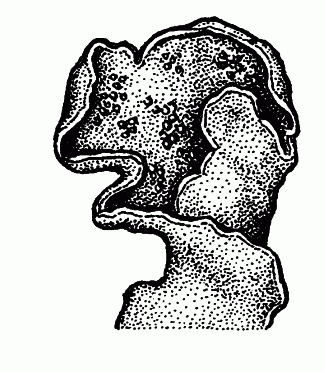Collema undulatum Laurer ex Flotow
Mourning tarpaper
Introduction to the Lichens
Mourning tarpaper
Introduction to the Lichens
Map
Distribution of Collema undulatum unavailable
SUBTAXA PRESENT IN BC
Collema undulatum var. granulosum
Species Information
General:
Common Name: The Tarpaper Lichens. Stresses the blackish nonstratified medulla that becomes somewhat swollen, translucent and jellylike when moistened.
Minute to occasionally large nonstratified foliose lichens (gelatinous when wet), lacking true cortex, (except cortex present on apothecial margin: see below) isidiate or not, lobes closely appressed to semi-erect, 0.5–10 (–15) mm wide, thin to thick. Upper surface dark olive brownish or blackish (ours), dull. Lower surface dark, rhizines absent or rarely present. Medulla absent. Photobiont blue-green.
Apothecia located over upper surface or marginal, with thalline margin, disc reddish brown; spores 2- to multicelled, ellipsoid to needle-shaped/acicular, (4–) 8 per ascus. Over bark, earth and rock, usually base-rich.
Notes: Collema is a taxonomically difficult genus comprising about 80 species, of which 35 are known to occur in North America and 20 in B.C. Chemistry is of no diagnostic value in this genus. Two keys are provided. The first key emphasizes macroscopic vegetative characters, though spore characters have been incorporated in some places. The second key, to nonisidiate species, stresses spore characters and is more technical.
Species description:
Lobe margins hairless; isidia, if present, also lacking hairs AND
Thallus foliose or, if somewhat fruticose, then lobes proportionally much shorter and broader; habitat and distribution various AND
Lobes brownish to olive-brownish or blackish, but never jet black above and below; rarely pruinose; habit, substrate and distribution various AND
Isidia absent or, if present, then either essentially globular throughout or becoming cylindrical or branched/coralloid at maturity; scalelike lobules absent (or sparse in some specimens of C. furfuraceum) over upper surface AND
Lobe thickness uniform throughout, lobe tips scarcely (if at all) more swollen than central portions of thallus; upper surface sharply and finely wrinkled or not; central portions of thallus dull (except occasionally shiny in C. nigrescens) AND
Upper surface distinctly isidiate, isidia globular or cylindrical, usually basally constricted AND
Lower surface naked or, if partly hairy, then hairs/hapters occurring in scattered tufts AND
Lobes averaging to less than 5 mm wide; isidia often (but not always) more than 0.2 mm wide; upper surface not pustulate (except usually weakly pustulate in C. fuscovirens) AND
Upper surface bearing only more or less globular isidia (Note: elongate isidia-like lobules may be present along lobe margins); habitat various AND
Central portions of thallus not strongly swollen, averaging to less than 0.2 mm thick when moist; isidia more randomly scattered, not in lines; distribution various AND
Lobe margins and lobe tips weakly or not isidiate or lobulate; lobes appressed to weakly ascending, but never distinctly erect AND
Lobes averaging to more than 1.5 mm wide; upper surface pustulate or not; isidia usually rather sparse or at least not obscuring lobes AND
Upper surface never pustulate; isidia usually averaging to less than 0.2 mm wide; over (mossy) rock or soil; spores 4-celled, septa transverse
Comments:
Only var. granulosum Degel. is reported from B.C. A few unusually swollen specimens collected from trees are tentatively included here, but are possibly better referred to the C. tenax group.
Source: Lichens of British Columbia
Illustration

If more than one illustration is available for a species (e.g., separate illustrations were provided for two subspecies) then links to the separate images will be provided below. Note that individual subspecies or varietal illustrations are not always available.
Illustration By: Trevor Goward
Habitat and Range
Habitat: Infrequent over base-rich rock or soil at lower elevations throughoutWorld Distribution: circumpolar.
Source: Lichens of British Columbia